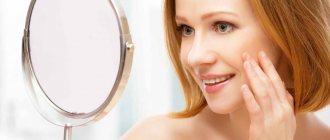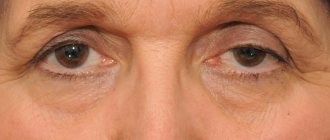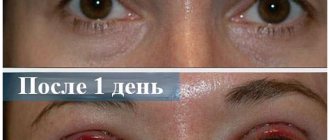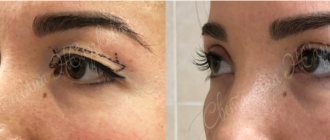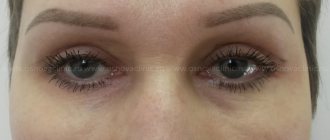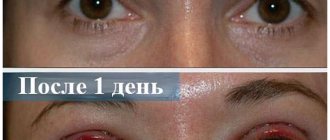Temporal lift refers to surgical interventions performed in the upper third of the face for the purpose of rejuvenation and lifting of soft tissues. As part of the operation, it is possible to raise the eyebrows, eliminate wrinkles in the outer corners of the eyes, and restore expressiveness to the eyes. Many women also turn to a plastic surgeon to create the effect of “oriental eyes” (the so-called “Cleopatra look”), when the eyelids are slightly raised and the corners of the eyes narrow, giving the eye shape a characteristic almond shape.
general information
When asked about the difference between blepharoplasty and the “Cleopatra’s Look” technique, surgeons explain that the latter is a variation of the former. The operation is performed separately or in combination with other eyelid correction procedures (lower blepharoplasty), rhinoplasty, facelift. Due to the fact that the plastic surgeon individually selects the angle of the incision, the scars after surgery are not visible. On the contrary, those around you notice a changed shape of the eye, which rejuvenates the face by 10 to 20 years.
By the way, they resort to it not only in adulthood. As practice has shown (and the number of women who have “made” themselves almond-shaped eyes has already exceeded 1000), the result of the procedure suits beautiful women of all ages.
Indications for eye shape correction, do you need the procedure?
Of course, there are no indications for obtaining almond-shaped eyes. The only reason for such a procedure is the patient’s desire. If the shape of the eyes does not suit her, plastic surgery to obtain an almond-shaped incision is indicated.
Eye surgery is suitable for young girls to change the shape and shape of the eye. Likewise for older women, in this case the procedure simultaneously allows you to remove signs of aging on the face and give it a fresh, youthful look, as well as the seductive look of Cleopatra.
Photo before after blepharoplasty - Cleopatra's eyes
Photo before after blepharoplasty - Cleopatra's eyes
Indications and contraindications
The main indications for the operation using the “Cleopatra’s Look” method are aesthetic: it eliminates congenital and acquired eyelid defects. There are no age restrictions; you can go under a scalpel as soon as you reach 18 years of age.
Meanwhile, most of the patients are women over 35 years old. As they age, the corners of their eyes naturally droop. The situation is aggravated by overhanging skin folds and wrinkles in the lower eyelid area, which make the look heavy, tired, and dissatisfied.
Like other types of blepharoplasty, Cleopatra's Look has contraindications, including:
- systemic diseases, diseases of internal organs, including heart problems;
- hypertension;
- increased intraocular pressure;
- bleeding disorders;
- oncology;
- dry eyes;
- high intraocular pressure;
- thyroid diseases;
- diabetes;
- AIDS;
- hepatitis;
- myopia and frequent relapses of conjunctivitis, other chronic diseases of the organs of vision.
During consultations with narrow specialists in preparation for the operation, other factors may be identified that impede its implementation at the moment.
Types of blepharoplasty
The cost of the operation in the case of blepharoplasty is an important factor, but it should not be the only decisive factor when choosing a clinic. It is also important to choose a qualified doctor. He will be able to accurately determine the cause of dissatisfaction with the appearance and advise the right solution.
There are the following types of operation:
- Upper eyelid surgery . During this procedure, overhanging tissues are excised and fatty hernias that interfere with vision are removed. Correction of age-related changes most often begins with it, so it rightfully occupies a leading position in the number of procedures.
- Blepharoplasty of the lower eyelids . Involves removing hernias under the eyes and bags. It is often done to get rid of sagging skin, morning swelling, and a sharp transition between the cheek and eyelid.
- Circular . It is performed on the upper and lower eyelids, allowing for a more pronounced effect.
- Canthoplasty . A type of surgery that changes the shape of the eyes. It is popular in Asian countries, where young people use it to widen their eyes, seeking Europeanization. This opens the door for them to a position in an international company. Less commonly, canthoplasty is used to achieve an Asian eye shape.
- Canthopexy . Surgery to tighten and fix the outer corners of the eye.
In addition to the type of operation, the doctor agrees with the patient on the method. There are 3 main ones:
- Classic - incisions are made on the outer surface of the eyelid, through which all manipulations are carried out.
- Transconjunctival - tissue is cut on the inside of the eyelid, and no traces remain after the operation.
- Combined - when choosing it, serious problems are solved with a scalpel. Small ones, in the form of scars, wrinkles, unevenness of the skin - with the help of a laser. Laser resurfacing, which is exactly what the procedure is called, tightens and refreshes the skin.
Laser resurfacing is considered a minimally invasive rejuvenation method. When it is carried out, the edges of the incision are instantly sealed. Blood loss in this case, however, as well as the risk of microorganisms entering the wound, is minimal.
Patients can choose the ultrasonic skin lifting method, but there is no guarantee of results. In 10% of cases of surgical interventions, no visible changes occur.
There are other methods for correcting age-related changes. Among them:
- Fat-sparing blepharoplasty is performed in the presence of fatty hernias of the upper and lower eyelids, which are not excised, but are evenly redistributed. This allows you to straighten the nasolacrimal groove and prevent the eye from drooping.
- Contour plastic surgery is an injection blepharoplasty, the price of which is correspondingly lower than the price of a procedure with surgical intervention. It consists of injecting hyaluronic acid-based preparations under the skin, which restore the lost “framework” to it.
With all its advantages (contour plastic surgery provides an immediate rejuvenation effect and is characterized by a minimal rehabilitation period), this procedure has one serious drawback - its fragility. The drugs dissolve within a year, and it has to be repeated.
Preparation
When preparing for Cleopatra's Look, contraindications are excluded. The latter are identified by the results:
- biochemical and clinical blood tests;
- tests for HIV, hepatitis;
- coagulograms;
- fluorography;
- ECG.
A consultation with an ophthalmologist is required, who will check vision and, if necessary, the volume of tear fluid. At an appointment with a cardiologist, cardiovascular diseases are excluded, and with a therapist, hypertension is ruled out.
If the operation is combined with correction of the lower eyelids, the patient may be advised to consult a nephrologist, endocrinologist, or allergist, since swelling under the eyes or fatty hernias (bags) sometimes appear with diseases of the thyroid gland, kidneys, or a persistent allergic reaction.
The last stage is a visit to an anesthesiologist who will help you choose anesthesia. The author of the technique himself uses local sedation. But when an allergic reaction to novocaine, lidocoine and other anesthetics is detected, general anesthetics are used.
Immediately before plastic surgery, it is important to remove lenses and eyelash extensions. Before surgery, any salon procedures are contraindicated. If possible, a few days before the procedure, you should stop taking any medications, especially those that can cause bleeding, or warn your doctor about them. In particular, we are talking about aspirin, homeopathic, anti-inflammatory medicines, and vitamin complexes. Usually, treatment can be resumed no earlier than 3 to 4 days after surgery.
You also need:
- stop smoking - nicotine slows down the process of tissue regeneration, prolonging rehabilitation time;
- Keep hydrated before and after the procedure - this speeds up the healing process.
Visiting the solarium is also prohibited.
Progress of the operation
If local anesthesia is used, the patient is immersed in a shallow sleep, in which she does not experience discomfort. Then, according to the technique, the plastic surgeon makes an oblong incision along the upper eyelid at such an angle that the scars after plastic surgery remain invisible. Fatty tissue and excess skin are excised and the outer corners of the eyes are raised.
On average, everything takes from 30 minutes to 2 hours, depending on the complexity of the case. Then cosmetic stitches are applied and sealed with a special adhesive plaster. Within an hour after the operation, the patient is usually sent home, making sure that her loved ones will be able to stay with her during the first 24 hours.
How the procedure occurs, features of eye surgery
Forming almond-shaped eyes is a simple procedure. It has a number of features that allow it to gain more and more popularity, guaranteeing a woman excellent results. Among the main features of plastic surgery it is worth noting:
- relative simplicity, all stages of plastic surgery occur in a row, the duration of the procedure, even in the most complex version, takes no more than 2 hours;
— to correct the shape of the eyes, general anesthesia is not required; eye surgery is performed under local anesthesia and sedation. This means that there are significantly fewer contraindications to the procedure, and the result is as predictable as possible;
— due to the absence of general anesthesia, the recovery period is quite short and does not require any special restrictions. Recovery occurs in 14 days, swelling and bruising may be observed for the first 2–3 days, on the 4th day the stitches are removed and healing occurs very quickly;
— the thinnest incision during eye surgery is hidden in the natural crease of the eyelid, which guarantees its inconspicuousness. This means there will be no traces of the plastic surgery experienced!
Photos before after eye surgery
Photos before after eye surgery
Cleopatra's look photo before after eye surgery
The restrictions on plastic surgery are very small - avoid bright sun and tanning for several weeks, give up makeup for 14 days. The result of plastic surgery is very lasting, the shape of the eyes will no longer change, and aging slows down, leaving the beauty of the eyes even after 60.
Recovery
After local anesthesia, women recover faster and easier, as they do not have headaches, dizziness or disorientation. The most difficult thing is in the first 3 days, when swelling increases, hematomas appear. To get rid of them faster, you need to provide your eyes with complete rest, and yourself a break from physical and mental stress.
The stitches are removed on the 5th day. In general, postoperative rehabilitation lasts 7–10 days, after which the woman can return to her usual routine. The first results are noticeable after 12 - 14 days, but the final results can be assessed only after 2 - 3 months.
At this time, the doctor additionally recommends applying ointments, making compresses, and leading a healthy lifestyle. In addition, it is better to sleep with your head elevated and spend less time in the sun.
Below are photos before and after blepharoplasty using the Cleopatra's Look method:
What is blepharoplasty
Eyes are the mirror of the soul.
It is in them that we look at the first meeting, trying to unravel the person standing in front of us; we read emotions from them, judge the state of mind. And if at the age of 20 judgments are faultless, then after 35–40 years the situation worsens. The first impression is spoiled by the inevitable age-related problems - deep wrinkles, sagging skin, bags. They add at least 10 years of age and make the gaze heavy and gloomy. It is useless to fight them alone. The reason for these problems lies in insufficient collagen production with age, drying out of thin skin, as well as a colossal load on the area around the eyes (just imagine: the average person blinks about 15 times per minute). But you shouldn’t put up with it either. It is better to turn to specialists who have a lot of quick and safe means to solve them.
One of these means is blepharoplasty - surgical correction of the eyelids, which is used when it is necessary to eliminate age-related changes, the desire to change the shape and shape of the eyes, or to get rid of congenital or acquired pathologies.
- general information
- Indications
- Preparing for surgery
- Types of blepharoplasty
- Carrying out the operation
- Recovery period
- Complications after blepharoplasty
- Blepharoplasty: photos before and after surgery
- FAQ
Forecast
When choosing a good plastic surgeon, patients are usually satisfied with their appearance.
Complications rarely occur:
- swelling;
- cyanosis;
- tearfulness;
- infection, conjunctivitis;
- noticeable scars, for example, if the incision is made far from the natural fold.
It is worth noting that these complications are not always the result of surgeon errors when planning and performing the operation. Any surgical intervention is an injury to which the body can react in different ways. At the same time, an experienced specialist knows not only how to avoid these mistakes, but also how to help the patient recover faster.
The result of the technique lasts 10–12 years, depending on the patient’s genetics and lifestyle.
(2 ratings)
Complications
If the operation is performed by an experienced specialist, the risk of complications is minimal. Blepharoplasty is akin to jewelry work and requires experience and skills.
The following complications may develop:
- severe swelling, hematomas, heaviness of the eyelids;
- dry eyes;
- photophobia, visual impairment;
- seam divergence;
- purulent-inflammatory processes;
- blepharoptosis;
- glaucoma, blindness;
- violation of eye symmetry.
The first usually go away on their own, however, if they occur, you should not delay visiting a doctor. In the end, he will recommend remedies to alleviate the condition and speed up recovery.
The appearance of serious cosmetic defects is observed, as a rule, with the wrong choice of technique, and less often with an abnormal tissue reaction. But in order to exclude it, a full examination is carried out at the preparation stage.



